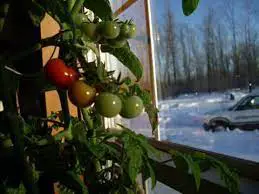Last Updated on April 11, 2024 by Real Men Sow
Although tomato plants are perennials, they can be frost-tender and won’t survive the winter. However, I have had success overwintering my cherry tomatoes in the winter. This is how to freeze tomato cuttings to get a head start on spring planting.
How To Over-Winter Tomato Plants Without A Greenhouse
Tomatoes are technically considered perennials, but they are still grown here as an annual. It is possible to keep a tomato tree alive through the winter. Gardeners who have a greenhouse are able to bring their tomatoes in before the first frost so that they have vine-ripe tomatoes in the fall.
So they can start tomato seeds early in spring, so that big, healthy plants are ready for planting when it’s warm enough. If you don’t have one, it wouldn’t get warm enough to keep your tomato plants going in winter without heat.
Overwintering Cherry Tomatoes in the Winter Indoors
If you keep your tomato plants alive in a container you can move inside before the first frost, you can keep them going all winter. It may or not bear fruit in winter depending on how warm your house is and how much light it gets.
Tomato plants like daytime temperatures between 70°F and 85°F, while nighttime temperatures range from 59°F to 68°F. For container size, larger is better. For one plant, a five-gallon container is sufficient. Drainage holes must be provided in containers to ensure that the plant doesn’t sit in water. Tomato plants don’t like “wet feet”.
To prevent water from destroying your floors and furniture, tomato plants should be kept indoors in a shallow saucer.
Overwintering Tomato Cuttings
It is very simple to cut tomato plants into pieces and then root them in water. Although you can almost succeed, some tomato varieties will root better than others. Once the cuttings have grown roots, you should plant them in the soil. They will grow in water but will eventually become very tall and outgrow the jars or glasses of water they have.
Tomato plants can be very heavy drinkers so it’s important to monitor the water level and add water if necessary.
If you have water that has been treated and piped to homes. Fill a glass with water and leave it alone for at least 24 hours. This is not necessary if you have well water. However, if you have city water, it is best to let the chlorine evaporate.
Potting Up Tomato Cuttings
Plastic cups are great for pots. They’re also inexpensive, and you can use a Sharpie to write on them so you remember which varieties you have. You can use a sharp knife or a pen to make a few holes in the bottom of your cup
Place about an inch of potting soil into the cup’s bottom. Plant your cuttings deep so that there isn’t too much soil at the bottom. Place the rooted cutting in the cup. Add potting soil to the stem and roots. If you prefer, you can add soil to the roots with a spoon. If possible, allow roots to spread through the soil.
Once the cup is full, you can tamp down the soil or compact it with your fingers. Then, add more to raise the level. All along the buried stem, new roots will be developed by the plants.
The potted cuttings should be watered well. Once the cups have drained, place them in the sink. Keep in mind that they have lived in water for the past winter so they will require plenty of water to adapt to their new environment.
They don’t like wet roots so make sure that the soil drains easily. These plants can be transplanted into larger pots if necessary before spring. After the danger of frost has passed, you can plant tomatoes in your garden.
Save Tomato Seeds for Winter
Save the seeds from my tomatoes because some seeds can be difficult to find. The backup plan should be to take cuttings in the fall to keep warm and then save seeds for spring planting.
Keeping Records
Keep track of the varieties that you are overwintering if you have more than one tomato variety. Even if you only save cuttings from one variety, keep track of when and how well the cherry tomatoes in the winter did.
Sharpie pens can be used to write on glass jars or plastic cups. This will help you keep track of which plants you have.
Here are some details you need to keep track of:
- Do you grow hybrid or heirloom varieties?
- Are they indeterminate plants?
- Which date were you able to take the cuttings?
Different varieties will grow better from cuttings than others. The only way to discover which variety works best is by trying different things and keeping track of the results.

